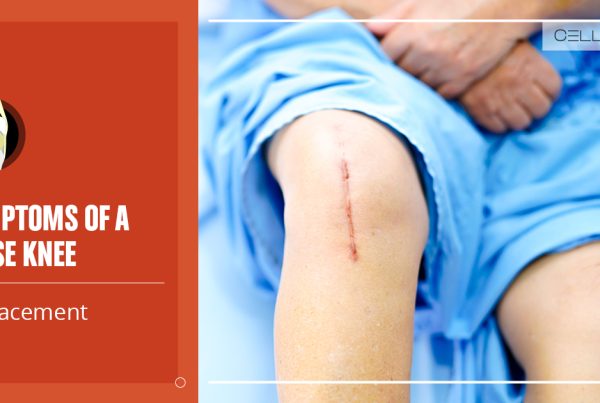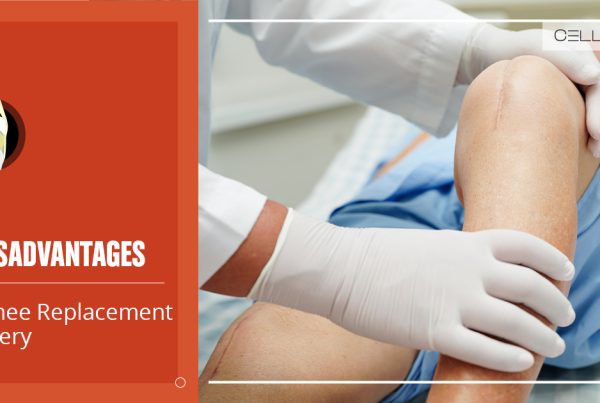Published on: March 14, 2024 | Updated on: January 18, 2025
A total knee arthroplasty or a knee replacement surgery is a procedure in which the surgeon replaces a damaged, worn, or diseased knee joint with an artificial prosthetic device that carries out the knee’s functions.
Every year, hundreds of thousands of people undergo knee replacement surgery. While 90% of these individuals experience a reduction in pain, there are many complications, too.
You should know about the disadvantages of knee replacement surgery before you opt for it. Similarly, it’s important to be familiar with alternative treatments like stem-cell therapy and plasma-rich platelet therapy (PRP).
Disadvantages of Knee Replacement Surgery
A knee replacement surgery could be essential to improve a patient’s quality of life. In most cases, it results in an excellent outcome. However, it also has its downsides.
Blood Clots
Blood clotting is a common aftereffect of surgery. The same also happens in knee replacement surgery, resulting in blood clots in the leg.
If the blood clot forms in a deep vein, it can cause deep vein thrombosis (DVT). The condition can vary in severity and may or may not show symptoms.
Some warning signs of DVT are:
- Heavy ache in the knee
- Warm skin around the knee
- Pain in the calf or foot
- Tenderness or swelling in the area
If a patient develops a painful blood clot, doctors usually prescribe anticoagulants to get rid of it. In rare cases, the blood clot in your leg could travel to the lungs, causing pulmonary embolism. That’s a serious condition requiring immediate medical attention.
A study found that 1.2% of people who undergo knee replacement surgery are hospitalized 90 days following the procedure. Of these, 0.3% have pulmonary embolism, and 0.9% come with DVT.
Wearing Out of the Replacement Joint
The artificial knee joint, also called a prosthesis, is made of metal and plastic parts. It’s designed to last for 15-20 years in most cases, but the joint can wear out faster if it is used excessively.
If a young patient gets knee replacement surgery, it’s likely that the artificial joint will wear out in their lifetime. So, they will need revision surgery in the future.
There is a 6% chance you’ll need a revision surgery five years following knee replacement surgery. The likelihood of revision is 12% after ten years.
Infection Risk
In 1981, the infection risk for a knee replacement surgery was thought to be 9.1%. Over time, new antibiotics and antiseptics have significantly reduced the risk to 1-2%.
Older, obese, and diabetic individuals are at a higher risk of infection.
Osteolysis
Osteolysis is the process of bone loss that occurs around the prosthesis. The microplastic in the knee implant can get inflamed due to the body’s immune response and cause an abrasive reaction in the tissues surrounding the joint.
Besides bone destruction, osteolysis also causes the knee impact to loosen over time. Osteolysis is the most common reason for revision surgery following knee replacement.
Pain and Stiffness
Knee replacement surgery itself is the solution to knee pain, but sometimes, it can result in more pain and stiffness. The statistics surrounding the occurrence of knee pain following surgery vary. However, almost 20% of individuals still have persistent knee pain after surgery.
Stiffness is also a common complication in this regard. After surgery, scar tissue can form in the joint, leading to a decrease in range of motion. Following the exercise regimen the doctor has provided can help reduce the likelihood of stiffness.
Nerve and Tissue Damage
Among all the disadvantages of knee replacement surgery, this one occurs during surgery and not after it. There’s a risk of a ligament, nerve, or blood vessel around the knee getting damaged during surgery.
Although this is not very common, it’s still a risk one should be aware of. The damaged nerves and tissues will increase the recovery time post-surgery.
New Knee Issues

New Knee Issues
Most patients report an improvement in the quality of their life after knee replacement surgery. However, some people may have the following problems with the prosthetic knee:
- Instability or looseness of the implant
- Knee pain due to improper alignment of the components
- Ongoing stiffness
- Difficulty bending the knee
- Difficulty walking correctly
Leg Length Differences
During knee replacement surgery, the surgeons also correct conditions like bowlegs or knock-knees. However, this can lead to leg length discrepancy post-surgery.
If there’s a significant difference in the length of both legs, it can cause back pain and gait imbalance. Sometimes, it may also cause ankle, hip, and lower back problems. A shoe insert or prosthetic limb may be used to correct the issue.
Factors That Make Your Prone to Disadvantages of Knee Replacement Surgery
Some factors may increase your risk of experiencing the disadvantages of knee replacement surgery:
- Age: Older individuals are at higher risk of complications after surgery.
- Weight: Being overweight can make it harder to recover after knee replacement surgery. It may also increase your risk of revision surgery and stiffness.
- Health: Pre-existing medical conditions such as diabetes, heart disease, or poor circulation also put you at risk of complications.
Alternatives to Knee Replacement Surgery
The innovation in regenerative medicine has allowed us to explore alternatives to knee replacement surgery that are less complicated and minimally invasive. Two common alternative treatments are stem cell therapy and platelet-rich plasma therapy (PRP).
Since these procedures are outpatient, you will be able to go home on the same day. CELLAXYS offers both of these treatments. The one you qualify for will depend on your knee condition.
Cell-Based Therapy
In cell-based therapy, the surgeon will harvest your own cells and reinject them into the knee. The cells are taken from the bone marrow in a process called Bone Marrow Concentrate (BMAC) and from the adipose tissue (fat) in a process called Minimally Manipulated Adipose Tissue Transplant (MMAT). Both procedures barely take 1.5 to 2 hours.
Platelet-Rich Plasma Therapy (PRP)
PRP involves platelet separation from your blood and their rejection into the knee or any other injury site. When platelets enter the injury site, they promote quick healing. The procedure takes 45 minutes, allowing you to go home in no time.
CELLAXYS has a proven success rate of both stem cell therapy and PRP, so you can rest assured that your knee will be taken care of.
Sources
Footnotes
- Labek G, Thaler M, Janda W, Agreiter M, B. Stöckl. Revision rates after total joint replacement. The journal of bone and joint surgery. 2011;93-B(3):293-297.
- Chun KC, Kwang Mee Kim, Churl Hong Chun. Infection following total knee arthroplasty. Knee surgery & related research. 2013;25(3):93-99.
- Pedersen AB, Mehnert F, Søren Paaske Johnsen, Husted S, Henrik Toft Sørensen. Venous thromboembolism in patients having knee replacement and receiving thromboprophylaxis. Journal of Bone and Joint Surgery, American Volume. 2011;93(14):1281-1287.
- Burnett RSJ, Keeney JA, Maloney WJ, Clohisy JC. Revision total knee arthroplasty for major osteolysis. The Iowa orthopaedic journal. 2009;29:28-37.
- Wylde V, Beswick AD, Bruce J, Blom AW, Howells N, Gooberman-Hill R. Chronic pain after total knee arthroplasty. EFORT open reviews. 2018;3(8):461-470.
References
- Clinical Outcomes and Statistics of Knee Replacement. Healthline. Accessed 9/18/2023.
- Total Knee Replacement. OrthoInfo. Accessed 9/18/2023.
- Pulmonary embolism. NHS. Accessed 9/18/2023.
- DVT (deep vein thrombosis). NHS. Accessed 9/18/2023.
CELLAXYS does not offer Stem Cell Therapy as a cure for any medical condition. No statements or treatments presented by Cellaxys have been evaluated or approved by the Food and Drug Administration (FDA). This site contains no medical advice. All statements and opinions are provided for educational and informational purposes only.
Dr Pejman Bady
Author
Dr. Pejman Bady began his career over 20 years ago in Family/Emergency Medicine, working in fast-paced emergency departments in Nevada and Kansas. He has served the people of Las Vegas as a physician for over two decades. Throughout this time, he has been met with much acclaim and is now the head of Emergency Medical Services in Nye County, Nevada. More about the doctor on this page.
Dr Pouya Mohajer
Contributor
Pouya Mohajer, M.D. is the Director of Spine and Interventional Medicine for CELLAXYS: Age, Regenerative, and Interventional Medicine Centers. He has over 20 years of experience in pain management, perioperative medicine, and anesthesiology. Dr. Mohajer founded and is the Medical Director of Southern Nevada Pain Specialists and PRIMMED Clinics. He has dedicated his career to surgical innovation and scientific advancement. More about the doctor on this page.









